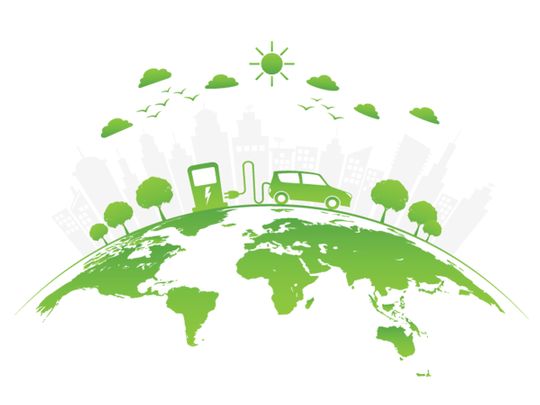
As the colour of energy turns from brown to green globally, India is shaping a silent revolution in the mobility sector - transforming Electric Vehicles (EVs) from a future possibility to present reality. This transition from internal combustion to electric, from polluting to clean transport, is both necessary and empowering for the country.
The switch to environment-friendly mobility is underway since India wants to fulfil the commitments it has made to the world and its people - to turn net-zero by 2070, cut 1 billion tons of carbon dioxide emissions by the end of this decade, and ensure that at least 30 per cent of all vehicles sold in country are clean by 2030 under the EV30@30 campaign, a multi-governmental policy forum.
The very process of scripting this shift towards greener transport is an empowering experience for the country as it involves the collective will and action of the political leadership, the Union and state governments, industry across the value chain and citizens, who are showing an increasing shift in sentiment towards being environmentally conscious in their lifestyle choices including their vehicles.
This movement is being led by Prime Minister Narendra Modi, who coined the concept of Panchamrit (five nectars) at the 26th session of the Conference of the Parties (COP26) to the United Nations Framework Convention on Climate Change (UNFCCC) in Glasgow last year. It laid down a five-pronged climate action framework which includes the country’s commitment to reduce emissions intensity of India’s GDP by 45 percent by 2030 from the 2005 levels, received a green signal from the Union Cabinet in early August.
Under this updated framework to be implemented between 2021-2030, there is a clear focus on incentivising clean energy industry including low emission products like EVs. The government is promoting green fuels for a long time and has a clear vision for zero emission mobility.
Regional and national governments are also pushing for electricity-based public transport to reduce pollution. This means taking electrification beyond personal vehicles to local buses, cab aggregation services and even last mile cargo delivery vehicles. It is also pushing for hydrogen-based transport technologies. It is expected the running cost of e-scooters, cars and auto-rickshaws will plunge to their petrol counterparts within the next two years.
Mobility technology is rapidly evolving around green options. Many experts are of the view that notwithstanding the faster evolution and adoption of battery electric vehicles (BEV), which are as of now cheaper to fuel cell electric vehicles (FCEVs), the tides will turn for hydrogen mobility within the next decade. Not only could FCEVs get significantly cheaper than BEVs, they are also likely to emerge as the cleaner option, needing lesser scarce raw materials (such as lithium, cobalt needed in BEVs) and being easier to recycle.
For India, which is aiming to meet the twin goals of positive climate action as well as achieve energy independence, it makes sense to keep its green mobility policy options open and back both electric vehicles and hydrogen mobility for the time being.
The government is proactive in the EV space and has incentivised the change by offering $1.3 billion funding for three years starting 2019 under phase-II of FAME (Faster Adoption and Manufacturing of (Hybrid and Electric Vehicles in India). About 16 state governments have created their own EV policies, with Uttar Pradesh, Delhi and Karnataka leading the show with highest number of EVs.
The biggest change of heart, however has been shown by the consumers. The high global petroleum prices, air-pollution and environmental concerns have also contributed to making consumers change their preference. While the number of EVs, according to data from Vahan, exceeded 1 million ended March 2022, the pent-up demand could be much higher. Once more as charging stations come up, safety aspects are addressed, and higher upfront cost come down as volumes go up, the adoption will be even faster.
While the industry - both large companies, and start-ups across the value chain have rolled up their sleeves to be part of the rapid transition towards green mobility, every such sectoral leap needs ecosystem support to succeed. India, for instance, would need about 5 million public charging points by 2030, a McKinsey estimate said in August 2018. That calls for an enormous jump from the current 1,742 public charging stations.
Unlike petrol stations, vehicles take longer to refuel in e-charging which means large expanses of parking space in urban centres will be required. The Confederation of Indian Industry’s report A Roadmap for Future Mobility suggests that urban local bodies could earmark quarter of their parking spaces for charging stations and plan decade-long leases on revenue sharing basis. Ensuring availability of adequate electricity at charging stations and lowering GST on charging services will improve user experience, encouraging EV usage.
The country is promoting investment in the Advanced Chemistry Cell (ACC) industry through a Production Linked Incentive (PLI) Scheme. The manufacturing ecosystem for Lithium-ion batteries and other battery storage technologies as well as the market for energy storage system is projected to grow at a faster rate soon. We also need to build our technical prowess and skilled talent through global partnership initially, and then through domestic investments. It is equally important to have an innovative framework for a circular economy around battery reuse and recycling.
In the hydrogen mobility space, the country is looking to promote equipment manufacturing ecosystem for green hydrogen—particularly through an extensive PLI scheme for electrolyser and its sub-component manufacturing. Efforts are being made to boost production and supply chain ecosystem for green hydrogen through special funds and clusters. CII is working with the Ministry of New and Renewable Energy for drafting regulations and standards to build robust environmental and safety standards for production, infrastructure, transportation, and use of green hydrogen. Simultaneously, the industry is working on transitioning to green hydrogen use and promoting research and development (R&D).
There is a consensus that the climate-change clock is ticking for India and the world. And if that clock is to reset, green mobility is not only a smart choice, it may be the only choice we have.
- The writer is Director General, Confederation of Indian Industry.














